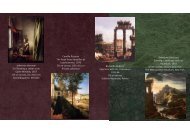Create successful ePaper yourself
Turn your PDF publications into a flip-book with our unique Google optimized e-Paper software.
A few convincing points were found in the visual qualities<br />
produced by Vermeer in his paintings to support the argument<br />
he used camera obscura.<br />
Variations principal planes of focus;<br />
precise diminution of ++;<br />
halation of highlights;<br />
precise treatment of reflections;<br />
closeness of the point of view to the window wall;<br />
precise convergence of parallel lines located in a plane<br />
perpendicular to the viewing axis;<br />
use of curtains to darken viewing room and control subject<br />
illumination;<br />
relative detail in still life portion versus figure detail;<br />
consistent proportions of the paintings (4-5:5 or almost<br />
square);<br />
dimensional precision in rendering objects.<br />
It is suggested Vermeer used this method on the<br />
“View of Delft”. This oil painting was painted on<br />
canvas around 1659-60, measuring 97cm x 116cm,<br />
which is now placed in Mauritshuis, The Hague. The<br />
painting was always labelled as his masterpiece and<br />
the most famous cityscape of the Dutch Golden Age,<br />
which covered majority of the 17th century. It was<br />
sold for the upmost amount of 200 guilders in the<br />
1696 auction of Dissius’s 21 Vermeer. The Mauritshuis<br />
bought it in 1822 for 2,900 guilders by the Dutch King,<br />
Willem I.





